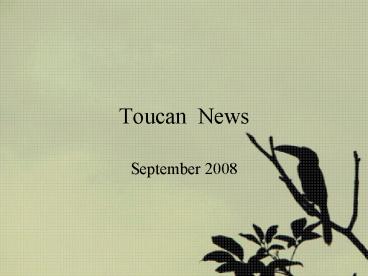Toucan News PowerPoint PPT Presentation
Title: Toucan News
1
Toucan News
- September 2008
2
Update
- For the third consecutive year, around the same
date (May), in the same tree, in the same hole, a
pair of toucans have nested and produced young. - Por tercer año consecutivo, una pareja de tucanes
ha anidado alrededor de la misma fecha (mayo), en
el mismo árbol, en el mismo hueco y ha producido
crías.
3
Where?
- The toucans nest (originally made by
woodpeckers) is on a conacaste tree. It can be
seen from the secondary portería. - Los tucanes hacen su nido en un hueco
originalmente hecho por pájaros carpinteros. El
hueco puede ser visto desde la portería de
secundaria.
4
Who watches them?
- Many children, administrative personnel, workers,
teachers, as they walk around campus, keep an eye
on them. Last May, Edwin Merches captured the
action. Click on and enjoy his pictures. - Muchos niños, personal administrativo, personal
de mantenimiento y profesores, mientras caminan
por el campus, gozan observándolos. En mayo
pasado, Edwin Merches capturó la acción.
Continúe y aprecie sus fotografías.
5
Fotos grandes aca, en varios slides
6
Fotos grandes aca, en varios slides
7
Fotos grandes aca, en varios slides
8
(No Transcript)
9
Fotos grandes aca, en varios slides
10
Fotos grandes aca, en varios slides
11
(No Transcript)
12
(No Transcript)
13
(No Transcript)
14
Something we know by just keeping an eye on
them...and asking many questions
- The toucans scientific name is Pteroglossus
torquatus - It feeds from the following trees at different
times of the year Ficus nitida (laurel de la
India), Dendropanax arboreus (mano de león),
Myrciaria cauliflora (jabotijaba), and Brassaia
actinophylla (a type of schefflera). It does not
eat human leftovers. - Share your nature observations with the upper
schools Biodiversity class (the classroom with
the turtles on the door!)
PowerShow.com is a leading presentation sharing website. It has millions of presentations already uploaded and available with 1,000s more being uploaded by its users every day. Whatever your area of interest, here you’ll be able to find and view presentations you’ll love and possibly download. And, best of all, it is completely free and easy to use.
You might even have a presentation you’d like to share with others. If so, just upload it to PowerShow.com. We’ll convert it to an HTML5 slideshow that includes all the media types you’ve already added: audio, video, music, pictures, animations and transition effects. Then you can share it with your target audience as well as PowerShow.com’s millions of monthly visitors. And, again, it’s all free.
About the Developers
PowerShow.com is brought to you by CrystalGraphics, the award-winning developer and market-leading publisher of rich-media enhancement products for presentations. Our product offerings include millions of PowerPoint templates, diagrams, animated 3D characters and more.

